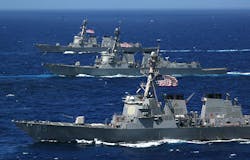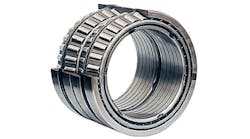The Timken Company received a multi-year contract worth over $1 billion from the U.S. Department of Defense to engineer and manufacture main reduction gears for the U.S. Navy’s ‘next-generation’ guided missile destroyer ships.
A main reduction gear (MRG) is a critical element of a ship’s propulsion system, the function of which is to connect a ship’s engine to its propeller shaft. The MRGs will be branded by Timken’s Philadelphia Gear subsidiary, a company it acquired in 2011 for $200 million. Philadelphia Gear produces high-performance gear drives, components, and related services.
Timken did not detail the start-date for the fixed-term contract, nor the number of MRGs to be supplied. A Timken representative suggested the contract would support new guided missile destroyers (DDGs) the Navy will build over the next decade.
It is the new contract’s options that would raise its total potential value over $1 billion.
"We've worked alongside the U.S. Navy for many decades and are proud to continue supplying our engineering expertise and Philadelphia Gear products and services for this important class of multi-mission ships," stated Timken’s Carl D. Rapp, vice president of the Power Systems group. "Philadelphia Gear won the contract to supply MRGs for the re-start of the DDG program in 2010 and, through the years, we have strived to deliver a quality product, on-time, and provide fleet support globally wherever the Navy serves our nation."
Guided missile destroyers are used for anti-submarine, anti-air, and anti-surface warfare, but mainly as launch vessels for guided missile systems. The Arleigh Burke (DDG 51) Class of guided missile destroyers was launched in 1988 and designed to function around the Aegis Combat System, a computer and radar-based missile defense and guidance system. More than 60 DDG 51s are in service today.
The DDG 51 class ships are powered by four General Electric LM 2500 gas turbine engines in a dual-shaft design that produces 100,000 total shaft horsepower, capable of achieving over 30 knots in open seas.
A modernization program is underway for the DDG 51 class vessels to ensure the vessels will maintain mission relevance and remain an integral part of the Navy's Sea Power 21 Plan. The modernization changes are being introduced to new-construction ships too, to increase the baseline capabilities of the newest ships in the class, and to provide commonality between new and modernized in-service ships.
The goal of the DDG modernization is to reduce workload requirements and increase war fighting capabilities, while reducing the USN’s “total ownership cost” to the Navy.
A new class of guided missile destroyers is expected to enter service in the early 2030s.
"As a result of our work with the Navy, our teams are prepared to meet the challenge of building reliable propulsion drives to support the demanding mission requirements of the DDG class for years to come," Timken’s Rapp stated.











